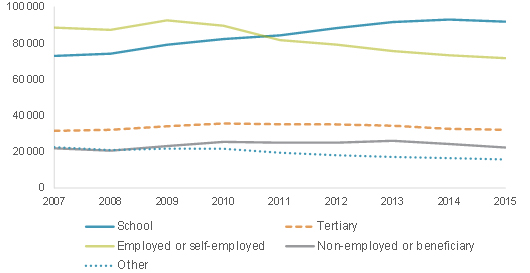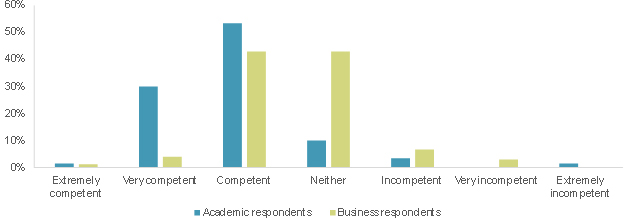
Content supplied by the Productivity Commission
During our recent inquiry into new models of tertiary education, the Productivity Commission learned a lot about New Zealand’s tertiary education system. Here’s ten things you might not know about tertiary education in New Zealand. Data sources and more detailed notes for all figures in this article can be found in the inquiry report.
1. Tertiary enrolments peaked in 2005
In 2005 just under half a million people were enrolled in New Zealand’s tertiary education system. The numbers participating in tertiary education increased dramatically from the mid-1980s, but have dropped away since 2005.
Enrolments in New Zealand tertiary education, 1880–2015

2. Tertiary students are increasingly likely to be engaged in a “traditional” conception of tertiary education
Many believe that technological advances will mean that people need different types of tertiary education and that there will be greater numbers seeking mid-career retraining or upskilling. Yet over the past decade, tertiary students have become more likely to be engaged in a “traditional” conception of tertiary education. The average student has become younger, and is more likely to be a school leaver. The share of extra-mural students (studying by distance) has declined, and fewer students are studying part-time.
Domestic full-time students by prior activity, 2007–15

3. Māori and Pasifika participate in tertiary education at higher rates than Europeans, but only at lower levels
Age-standardised participation rates in 2015 for Māori (14.5%) and Pasifika (11.4%) were higher than those for Europeans (9.7%). However Māori and Pasifika are less likely to study in university and their higher participation rates occur entirely in subdegree level study.
Age-standardised participation rates by ethnicity and level of study, 2015

4. Government spends nearly $4 billion each year on tertiary education
In 2015/16, government spending on tertiary education included:
- $2.43 billion in tuition subsidies paid to tertiary providers
- $526 million for research funding
- $486 million on student allowances
- $161 million administering the tertiary education system
- $134 million on capital expenditure, scholarships and other expenditure
Government also incurs significant costs as a consequence of the interest-free student loan scheme.*
5. Government spends twice as much on tertiary education subsidies for the well-off than on people from poorer communities
People from wealthier communities study for longer, and at higher levels. This means they receive higher levels of government subsidy. Given that they study for longer, students from wealthy backgrounds are also most likely to benefit from the inherent subsidy built into the interest free student loan scheme.
Average funding consumed per person by deprivation index (1990 cohort)

6. Government expects to recover 57 cents for each dollar loaned under the student loan scheme in 2015/16
Most domestic students are able to access the student loan scheme to cover course fees and some course-related costs, and to help with living costs. Loans are interest free while the borrower lives in New Zealand.
- In the 2015 calendar year, 182 500 students borrowed from the student loan scheme, with total lending of $1 522 million in 2015/16.
- At June 2016, there were 731 754 student loan borrowers (people who have borrowed at any stage that have not yet fully repaid their loan), and the nominal value of all outstanding loans was $15.3 billion.
The student loan scheme reduces the effective cost of study to students. Contingent repayment and a zero nominal interest rate mean students face a negative real interest rate and strong incentives to repay loans as slowly as possible. In addition, loans are written off when a borrower dies or becomes bankrupt, and a large proportion of overseas-based borrowers do not meet their repayment obligations. The combination of these features means the Inland Revenue Department writes off a significant share of the total amount loaned each year. Of the $1 522 million loaned in 2015/16, $659 million was written off – an average of 43.3 cents for each dollar lent, or a subsidy of around $2 800 per full-time student enrolled in 2015.
Student loan lending and initial write-down on lending, 2008/09–2015/16
| 2008/09 | 2009/10 | 2010/11 | 2011/12 | 2012/13 | 2013/14 | 2014/15 | 2015/16 | |
| New lending ($ millions) | 1 269 | 1 434 | 1 465 | 1 489 | 1 481 | 1 522 | 1 529 | 1 522 |
| Initial write-down ($ millions) | 532 | 728 | 713 | 702 | 536 | 629 | 602 | 659 |
| Average cost of lending (cents per dollar) | 41.92 | 50.77 | 48.67 | 47.15 | 36.19 | 41.33 | 39.37 | 43.3 |
7. Students typically meet around 20% of the cost of tertiary education
In 2015, students nominally paid an average of 29% of the full cost of their tuition through fees, with the remainder covered by government subsidies. However in practice, the government’s share is much larger, given that more than 40% of student loan debt is written off. The government’s share rises to around 82% after taking this into account.
Share of tertiary education costs at public tertiary education providers, 2007–15

8. Views about how well graduates are prepared for work differ widely
Opinions on how well New Zealand’s tertiary education system prepares graduates for employment are mixed. Tertiary providers and academics typically believe that their graduates are well-prepared, while employers are often less complimentary. For example, a 2013 survey of academics and businesses identified significantly different views regarding the ability of business schools to produce well-trained and prepared graduates.
Perceived ability of business schools to produce well-trained and prepared graduates

9. Little funding moves around the system
The Tertiary Education Commission allocates tuition subsidies to tertiary providers through an Investment Plan process. In theory, this allows the Tertiary Education Commission discretion to incentivise and reward high-performing providers by shifting funding around the system. But in reality, funding allocations are relatively static, with only a very small share of funding moving between different subsectors.
Tertiary subsectors’ share of funding 2008 – 2016
| 2008–10 | 2011–12 | 2013–14 | 2015–16 | |
| All universities | 59.3% | 59.1% | 59.7% | 60.5% |
| All ITPs | 25.7% | 26.1% | 25.1% | 24.3% |
| All wānanga | 5.8% | 6.1% | 6.2% | 6.1% |
| All PTEs | 9.2% | 8.8% | 9.0% | 9.0% |
The absence of significant shifts in funding is also apparent for individual providers. For example the University of Otago’s share of total funding has remained steady at between 11.2% and 11.4% over the past eight years.
10. Immigration is a larger source of new skills to the New Zealand labour market than local population growth
While young New Zealanders are an important source of skills for the labour market, migrants also make a major contribution. In all but five of the past 20 years, immigration has been a bigger source of new skills to the New Zealand labour market than local population growth. In recent years, a strong upswing in inward migration has resulted in new working-age migrants outnumbering New Zealand residents turning 15 by 39 900 in 2015, and by 44 500 in 2016.
Additions to the New Zealand labour market, 1997–2016

5 Comments
Number 10 - Why New Zealand has a low wage economy in one graph. Why both employing a training a graduate when you can just bring in some foreigner and pay them less?
Education is used to get residency by foreign student. No one comes here to study.
I'd love to see how the graph in number 1 would look on a per capita basis.
If the government ends up paying 82% of the cost anyway then that just makes a mockery of charging for university. I wonder if administration costs running the bureaucracy have been included within the 82% ?
NZ is running a permanent residency scheme for foreigners via its schools & universities
Nobody asked NZers to vote on that
The humanities are dominated by Marxists?
http://quadrant.org.au/magazine/2012/11/the-war-against-human-nature-ii…
http://heterodoxacademy.org/2015/09/14/bbs-paper-on-lack-of-political-d…
We welcome your comments below. If you are not already registered, please register to comment.
Remember we welcome robust, respectful and insightful debate. We don't welcome abusive or defamatory comments and will de-register those repeatedly making such comments. Our current comment policy is here.